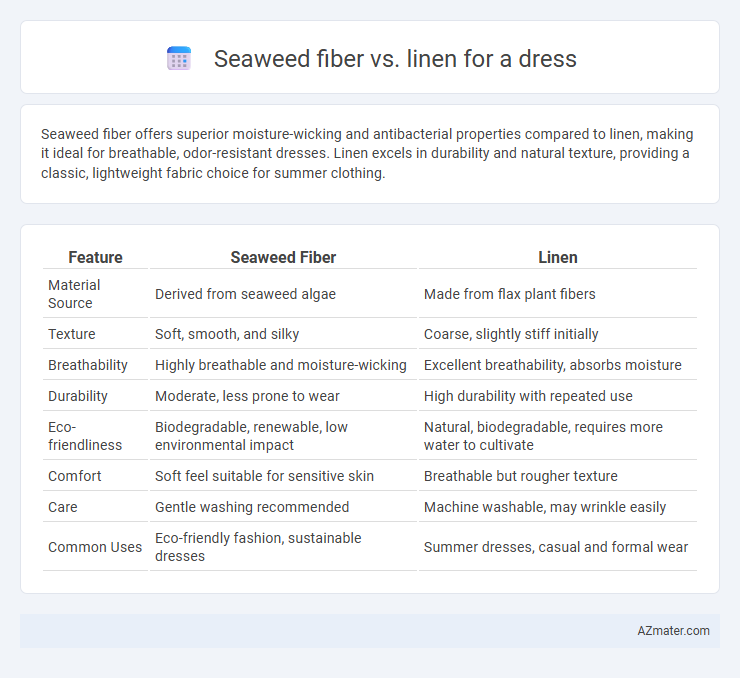Seaweed fiber offers superior moisture-wicking and antibacterial properties compared to linen, making it ideal for breathable, odor-resistant dresses. Linen excels in durability and natural texture, providing a classic, lightweight fabric choice for summer clothing.
Table of Comparison
| Feature | Seaweed Fiber | Linen |
|---|---|---|
| Material Source | Derived from seaweed algae | Made from flax plant fibers |
| Texture | Soft, smooth, and silky | Coarse, slightly stiff initially |
| Breathability | Highly breathable and moisture-wicking | Excellent breathability, absorbs moisture |
| Durability | Moderate, less prone to wear | High durability with repeated use |
| Eco-friendliness | Biodegradable, renewable, low environmental impact | Natural, biodegradable, requires more water to cultivate |
| Comfort | Soft feel suitable for sensitive skin | Breathable but rougher texture |
| Care | Gentle washing recommended | Machine washable, may wrinkle easily |
| Common Uses | Eco-friendly fashion, sustainable dresses | Summer dresses, casual and formal wear |
Introduction to Sustainable Dress Fabrics
Seaweed fiber and linen are both eco-friendly dress fabrics known for their biodegradability and minimal environmental impact. Seaweed fiber, derived from marine algae, offers natural antibacterial properties and moisture-wicking capabilities, making it suitable for active and casual wear. Linen, made from flax plants, excels in breathability and durability, giving garments a timeless appeal and strong sustainability credentials.
What Is Seaweed Fiber?
Seaweed fiber is an innovative textile material derived from seaweed extracts combined with cellulose, offering a sustainable alternative to traditional fibers like linen. This eco-friendly fiber boasts natural antibacterial properties, moisture-wicking abilities, and biodegradability, making it suitable for breathable and comfortable dress fabrics. Compared to linen, seaweed fiber provides enhanced softness and elasticity while maintaining durability and environmental benefits, appealing to conscious fashion consumers.
What Is Linen?
Linen is a natural fiber derived from the flax plant, known for its strength, durability, and breathability, making it a popular choice for dress fabrics. Unlike seaweed fiber, which is produced from algae and offers sustainable moisture-wicking properties, linen provides a crisp texture and excellent moisture absorption, ideal for warm weather clothing. Both fibers are eco-friendly, but linen's long-established use and natural resistance to bacteria set it apart in dressmaking.
Environmental Impact: Seaweed Fiber vs Linen
Seaweed fiber offers significant environmental benefits due to its rapid renewability, low water usage, and biodegradability, making it a sustainable alternative to traditional textiles. Linen, derived from flax plants, also boasts eco-friendly qualities with minimal pesticide use and the ability to grow in poor soil, resulting in low water and energy consumption. Both fibers have a reduced carbon footprint compared to synthetic materials, but seaweed fiber's regenerative ocean-based production provides a unique advantage in combating terrestrial agriculture impacts.
Comfort and Wearability Comparison
Seaweed fiber offers exceptional moisture-wicking properties and natural antibacterial benefits, providing superior comfort in warm climates compared to linen. Linen is highly breathable and durable but can feel rougher against the skin, especially when new, whereas seaweed fiber tends to be softer and smoother, enhancing wearability for sensitive skin. Both materials are lightweight and eco-friendly, but seaweed fiber excels in softness and odor control, making it ideal for all-day wear.
Durability and Longevity
Seaweed fiber offers impressive durability due to its natural cellulose content and resistance to stretching, making it a strong choice for sustainable dress materials. Linen, derived from flax fibers, is renowned for its exceptional longevity and ability to become softer with each wash while maintaining structural integrity. Both fibers provide durability, but linen typically outperforms seaweed fiber in long-term wear and resistance to wear and tear.
Breathability and Moisture Management
Seaweed fiber and linen both offer excellent breathability, but seaweed fiber excels in moisture management due to its natural bioactive compounds that enhance moisture absorption and antimicrobial properties. Linen, made from flax fibers, provides superior airflow and dries quickly, making it ideal for hot weather, but it lacks the inherent moisture-wicking benefits found in seaweed fiber. Choosing seaweed fiber for dresses ensures a smoother, odor-resistant wear experience in humid conditions, while linen emphasizes durability and crisp texture with effective sweat evaporation.
Aesthetic Qualities and Style Options
Seaweed fiber offers a smooth, silky texture with a subtle sheen, creating elegant and modern dress designs that emphasize fluidity and softness. Linen provides a natural, textured appearance with visible weaves, lending a casual, breathable, and rustic charm ideal for relaxed and bohemian styles. Both materials support diverse dress silhouettes, with seaweed fiber favoring refined, draped looks, while linen excels in structured, breathable garments perfect for warm climates.
Cost and Accessibility
Seaweed fiber is an emerging textile material often priced higher than linen due to limited production and specialized processing methods. Linen, derived from flax plants, remains widely accessible and cost-effective because of established cultivation and manufacturing infrastructure. Consumers seeking sustainable dress fabrics find linen more readily available and affordable compared to the niche market of seaweed fiber textiles.
Which Fabric is Best for Sustainable Fashion?
Seaweed fiber offers a highly sustainable alternative for dress fabrics due to its natural biodegradability, minimal resource consumption, and skin-friendly properties, making it ideal for eco-conscious fashion. Linen, derived from flax plants, is also sustainable with its low water usage, durability, and compostability, but Seaweed fiber provides added benefits such as natural antibacterial qualities and enhanced moisture management. Both fabrics align well with sustainable fashion goals, but Seaweed fiber's innovative environmental advantages often position it as the superior choice for eco-friendly dresses.

Infographic: Seaweed fiber vs Linen for Dress
 azmater.com
azmater.com